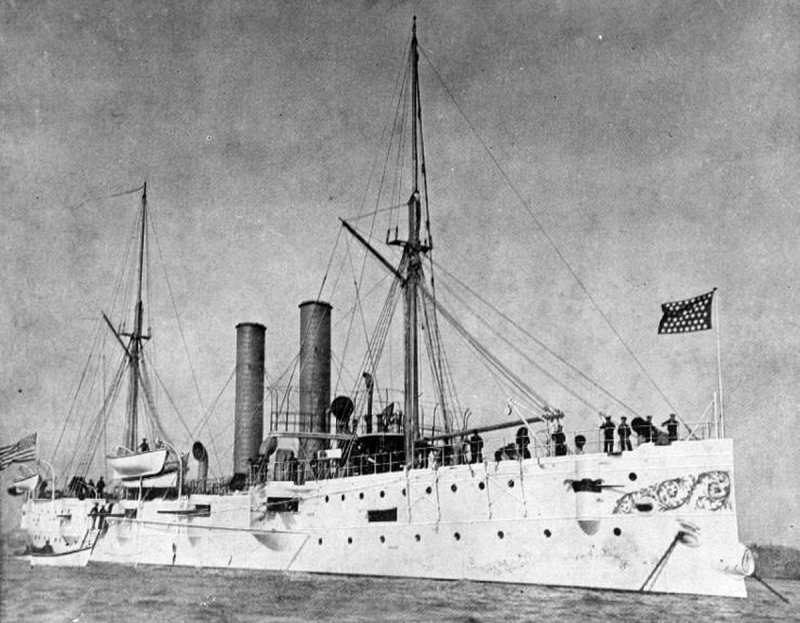| Precedente Successiva |
 |
| USS Brooklyn |
| Name: Brooklyn Namesake: City/Borough of Brooklyn, New York Laid down: 2 August 1893 Launched: 2 October 1895 Commissioned: 1 December 1896 Decommissioned: 9 March 1921 General characteristics Type: Armored cruiser Displacement: 9,215 long tons (9,363 t) (normal) 10,068 long tons (10,230 t)(full load) Length: 400 ft 6 in (122.1 m)(w/l) 402 ft 7.2 in (122.7 m) (oa) Beam: 64 ft 8 in (19.7 m)[3] Draft: 28 ft (8.5 m) Propulsion: 4 ? vertical triple expansion reciprocating engines 7 ? cylindrical boilers (5 double-ended, 2 single-ended) 2 ? screws Speed: 20 kn (37 km/h; 23 mph) Complement: 561 officers and men Armament: 8 ? 8 in (200 mm)/35 cal guns 12 ? 5 in (130 mm)/40 cal guns 5 ? 18 in (460 mm) torpedo tubes 4 ? six-pounder saluting guns[5] Armor: Belt: 3 in (7.6 cm) Turrets: 5.5 in (14 cm) Deck: 3?6 in (7.6?15.2 cm) Conning Tower: 7.5 in (19 cm) Barbettes: 8 in (20 cm) The second USS Brooklyn (CA-3) (originally ACR-3) was a United States Navy armored cruiser, the only to be named at commissioning for a city rather than a state. She was launched on 2 October 1895 by William Cramp and Sons Ship and Engine Building Company of Philadelphia, Pennsylvania; sponsored by Miss Ida May Schieren; and commissioned on 1 December 1896, Captain Francis Augustus Cook in command. Service history Spanish-American War Brooklyn 's first assignment was a special cruise to Britain with representatives of the U.S. for the Diamond Jubilee of Queen Victoria. The cruiser returned to the east coast in July 1897 and cruised there and in the West Indies until becoming flagship of the Flying Squadron under Commodore W. S. Schley on 28 March 1898. During the Spanish-American War, the Flying Squadron arrived at Cienfuegos, Cuba on 21 May and established the blockade of that port. On 26 May, the Squadron arrived at Santiago de Cuba, where the Spanish fleet was being held behind the protection of the forts. Brooklyn was a key vessel in the Battle of Santiago de Cuba on 3 July, in which the Spanish Fleet was destroyed. Although she was struck 20 times by whole shot, Brooklyn suffered only one man wounded (Fireman J. Bevins) and one man killed (Chief Yeoman George Henry Ellis). Brooklyn returned to Tompkinsville, New York on 20 August; cruised along the Atlantic coast and in Caribbean waters; participated in the Spanish-American War Victory Celebration at New York on 5 October; and in the Dewey Celebration at New York in September 1899. She left Hampton Roads on 16 October and sailed via the Suez Canal to Manila, Philippine Islands, where she arrived on 16 December. She became flagship of the Asiatic Squadron and participated in the China Relief Expedition (8 July?11 October 1900. She made a cruise to the Dutch East Indies, Australia and New Zealand from 10 April-7 August 1901; the last stage was to Melbourne, Auckland, Wellington and Sydney. She remained with the Asiatic Squadron until 1 March 1902, when she sailed for the United States via the Suez Canal and arrived at the New York Navy Yard on 1 May. Post-war On 20 May 1902, Brooklyn was at Havana, Cuba for the ceremonies to transfer the authority on that Island from the United States Government to the Cuban Government. In June?July, she was on special duty in connection with the obsequies of the late British Ambassador to the United States, Lord Pauncefote. During the next four years, she cruised with the North Atlantic Fleet and the European Squadron. She was involved in the intervention in Syria from 8 September to 17 October 1903 as well as the intervention in Djibouti from 21 November 1903 to 18 January 1904. Brooklyn returned to New York on 26 May 1905. On 7 June, as flagship of Rear Admiral Charles Dwight Sigsbee, she sailed for Cherbourg, France, where the remains of the late John Paul Jones were received aboard and brought to America. Upon arrival at Annapolis, Commodore Jones' remains were transferred ashore to a receiving vault at the United States Naval Academy with appropriate ceremonies on 23 July. Following a naval militia cruise (from 3?23 August 1905) and a tour in the Mediterranean (from 28 December 1905 ? 8 May 1906), Brooklyn went into reserve at the League Island Navy Yard in Philadelphia on 16 May 1906. Except for a short period (from 30 June?2 August 1906) in commission for special service at Havana, Cuba, she remained in reserve until the spring of 1907. From 12 April ? 4 December 1907, Brooklyn served as part of the permanent display at the Jamestown Exposition in Jamestown, Virginia. Following her return to Philadelphia, Brooklyn went into reserve again on 21 December. Placed out of commission on 23 June 1908, she was commissioned in ordinary on 2 March 1914. She was assigned to the Atlantic Reserve Fleet and served as receiving ship at Boston Navy Yard from 24 July 1914 ? 13 March 1915. She was placed in full commission at Philadelphia on 9 May 1915 and served on Neutrality Patrol around Boston Harbor until November, when she sailed to the Asiatic Station to serve as flagship for the Commander-in-Chief of the Asiatic Fleet. She attended to regular military and diplomatic duties in China, Japan, and Russia until September 1919, when she became the flagship of Commander, Division 1, Asiatic Fleet. In January 1920, she was assigned to the Pacific Fleet as flagship of Commander, Destroyer Squadrons, and remained there until 15 January 1921. Brooklyn was placed out of commission for the final time at Mare Island Navy Yard on 9 March and sold for disposal on 20 December. Awards ? Navy Expeditionary Medal (2 awards) ? Sampson Medal ? Spanish Campaign Medal ? Philippine Campaign Medal ? China Relief Expedition Medal |
| Username | |
| Armatore | USA Navy |
| Ship manager | |
| Numero IMO | |
| Classificazione | Cruiser |
| Cantiere e anno di costruzione | 1896 William Cramp and Sons Ship and Engine Building Company of Philadelphia, Pennsylvania |
| Data | |
| Luogo | |
| Aggiunta il | 26/10/2014 |
| Dimensioni | 1200 x 934 |
| visite | 1691 |
















